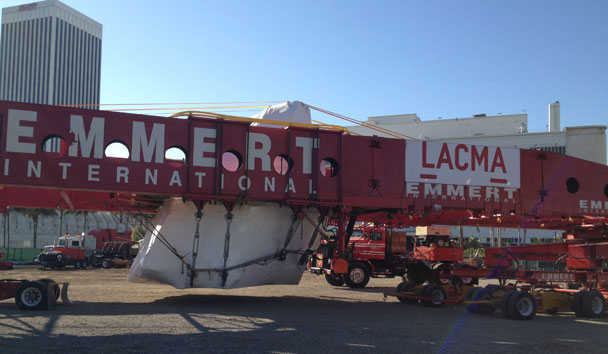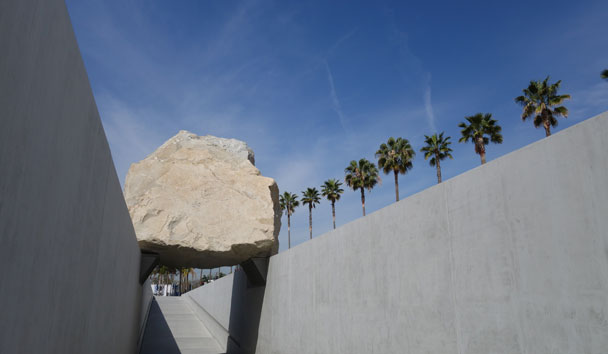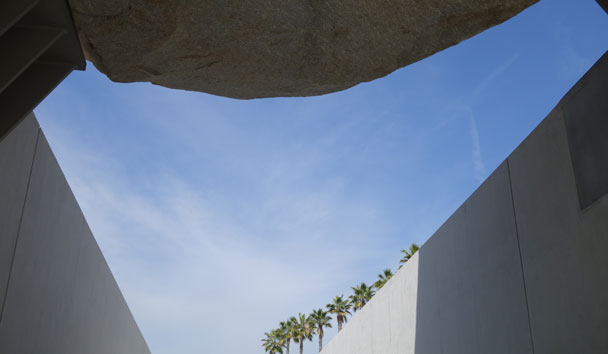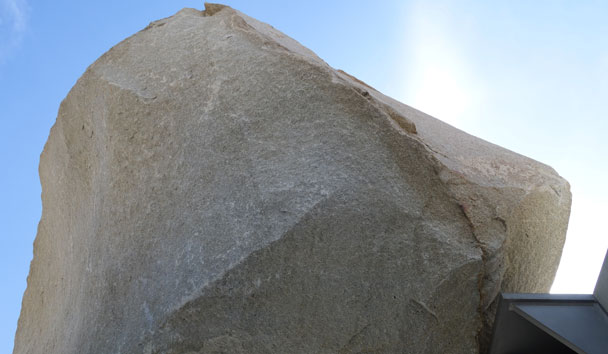Surely you all remember, and perhaps some of you witnessed, the 105 mile night-time journey of a 340-ton boulder through Los Angeles and its transformation into art as LACMA’s “Levitated Mass”. In the summer of 2012, “the Rock” became a national media sensation — at once a spectacle of wonder and a feat of engineering, and then unexpectedly, an incredible example of the public’s capacity for community. I was there when it arrived, shrink-wrapped, at LACMA encased in the comforting arms of Emmert International’s massive transportation apparatus.

If you’ve ever stood under “Levitated Mass” and wondered what all the fuss was about, Doug Pray’s fine new documentary, Levitated Mass: The Story of Michael Heizer’s Monolithic Sculpture, is for you. Pray’s film starts in a quarry in Riverside where boulders are blown up and huge rocks tumble down the craggy hillsides. The massive, ancient forms remind us of the elemental ideas that Land artists, Heizer being a key example, explore. It took Heizer years to find his rock, and his partner in the search was none other than the quarry manager (who called the artist after one day’s blast to say that he’d unearthed the perfect rock). The rock sat, isolated at the Riverside quarry, for years until Heizer could amass the funds to move it. The hero of the story is LACMA’s Michael Govan, who had worked with the artist on previous projects and who understood the seemingly mad ambition to set the monolith on a concrete slot for the world to view. That is… over 100 miles away at the museum’s mid-city campus.
It turns out, that’s where things got really interesting, and it’s a good think Pray was along to film the story.

The film masterfully tracks the multiple story lines of hundreds of people involved in this project: the engineers who had to solve the problem of moving the unwieldy object across the city, the team at LACMA who had to fundraise and engineer the creation of a permanent exhibition on site, and the web of city managers who had to be convinced to allow street traffic in their towns to be disrupted by the proposed journey. The film follows the massive convoy through LA, capturing the surprising reaction of citizens along the route who stayed up all night to witness the passage of the parade of engineers and trucks, and the Rock. Throughout the film, Pray introduces us to Heizer’s other massive artworks, and understanding the artist’s importance in exploring “negative space” helps garner a deeper appreciation of the rock’s new resting place at LACMA.

Time for Heizer is a relative thing – he remarks that a decade is “like a second” when it comes to bringing an idea to fruition. Heizer is a reclusive figure, and doesn’t appear in the film until the Rock arrives at LACMA. Heizer lived in a trailer on the LACMA campus (with his dog) during the installation of the Rock, and one of the film’s many pleasures is watching the engineers and museum officials work alongside the artist during the delicate process of setting the rock into it’s new resting place.
Ultimately, the film instills a geeky-love for the engineering of the whole crazy venture. Paired with a newfound appreciation for the long-term dedication of Heizer, and underlined by the mostly positive glimpse back at the willingness of Angelenos to come out and marvel at the new, Pray’s film offers a holistic view of the magical process that starts with an idea in an artist’s head and arrives at a by-now iconic piece of our urban landscape.
N.B. The film has a theatrical run until November (at LA’s Nuart until 9/11 and then at Laemmle’s Playhouse 7 in Pasadena and beyond). According to the film’s distributor, it will likely be on DVD and streaming at the beginning of December. If you’re interested, sign up for updates from firstrunfeatures.com.


